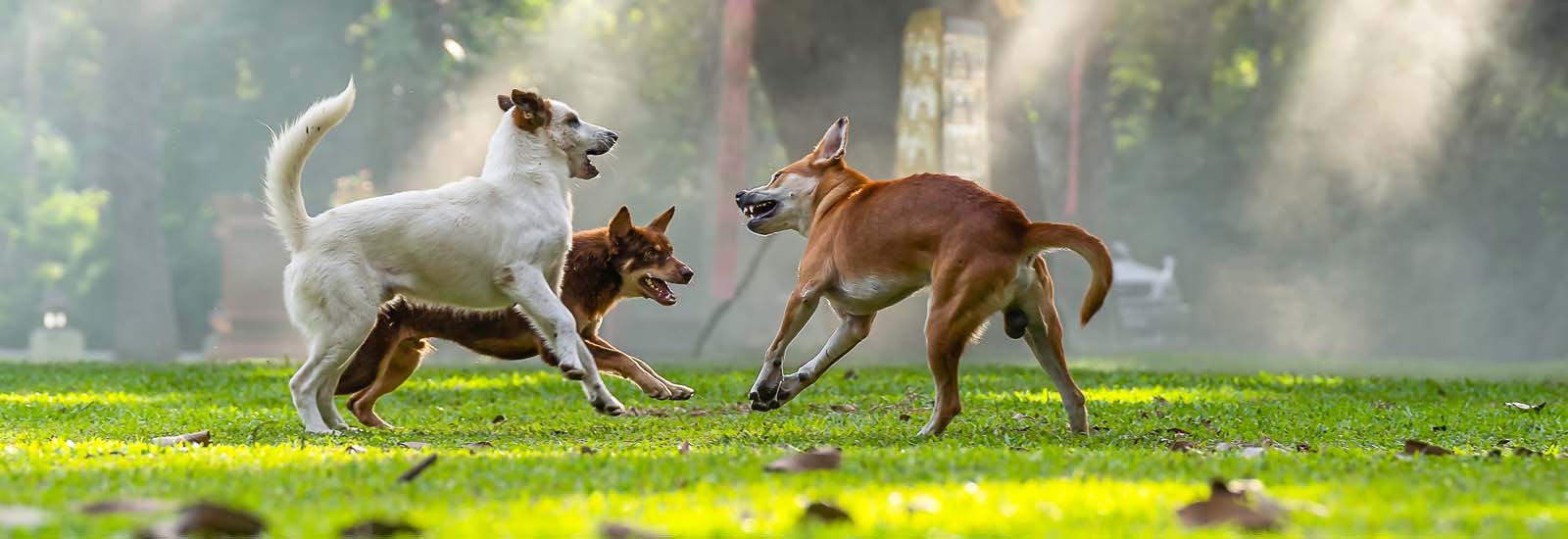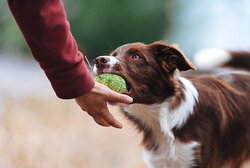My dog is behaving aggressively towards other dogs
Aggression in itself is important for many animals in order to survive. Threatening behaviours towards other dogs are therefore quite normal and acceptable. However, if the aggression gets out of hand, the cause must be identified and a solution found.
Aggressive behaviour is normal
Aggressive behaviour is completely normal in wild animals. It is one of the factors that decides who survives. Only those who manage to assert themselves will get enough food and a good place to sleep, and will be able to pass on their genes. However, the animal almost always takes care not to hurt others of the same species unnecessarily. The behaviour initially only has a threatening nature. This is often enough to make an opponent understand who is in charge and what they want from the other animal.
In dogs, this behaviour is still present even after a long period of domestication. When encountering each other, there will often be threatening gestures such as growling, baring of teeth, a direct stare or a display of dominance. This threatening behaviour should under no circumstances be punished. It serves as a warning to avoid a genuinely aggressive confrontation with another dog. If you try to stop these warning signals, your dog might immediately go on the attack next time.
Why is my dog behaving aggressively?
It is important to distinguish whether a dog is merely threatening another dog in order to make it understand that it should keep its distance, or whether it really is being aggressive and there is a danger of it biting. If the latter is the case, the cause must be identified. This can be, among other things:
- Insufficient socialisation
While your dog is still a puppy, it is important that it becomes familiar with a wide variety of everyday situations and learns to regard them as harmless. These include other people, animals and day-to-day experiences. If your dog has never encountered screaming children, tall men, vacuum cleaners, prams, bicycles or young people with skateboards, it will react insecurely. If your pet feels threatened by these things and has not had the opportunity to get used to them, it may react aggressively.
- Negative experiences
When you welcome a dog into your home, you never know what it has experienced in its life up to now. This is especially true for dogs from animal shelters. However, even a puppy that has been cared for by a breeder may have already had bad experiences. Perhaps it has been teased by children or frightened by someone at the garden fence. With dogs from abroad, many things can come together: perhaps they have been kicked, had stones thrown at them, had to fight for food or been bitten by another dog. All this leaves its mark on an animal and can make it feel threatened in certain situations and ready to fight for its life.
- Lack of obedience training
Good socialisation and obedience training provide the best basis for a stress-free relationship with your dog. Make sure you take your pet to puppy play classes at a reputable dog school, followed by a basic obedience course. Even if your dog does not immediately master reacting to commands like “down!” and “stay!”, it will still learn a great deal – above all, how to interact with other dogs.
After this, you should continue to train your dog. Remember that you are the leader of the pack. A dog is perfectly willing to be subordinate, however, you must always insist that your pet obeys your commands and never simply ignore any disobedience.
- Consider your own behaviour
If you pick up your small four-legged friend whenever it approaches another dog, or if you cross to the other side of the road in order to avoid them meeting, your dog will not be able to learn any social skills. The same applies if you yourself feel uneasy and your body language signals to your pet that an oncoming dog should always be regarded with suspicion. Be a confident pack leader who is in control of the situation! Otherwise you could pass on your mood to your dog on its lead and “leash aggression” may result.
- The dog is unwell
Although unlikely, it cannot be ruled out that the dog is unwell or in pain. This can lead to it keeping a greater distance than usual from other dogs and displaying aggressive behaviour at an early stage.

How can I recognise aggressive behaviour?
There are various forms of aggressive behaviour. In order to recognise them at an early stage and to be able to intervene accordingly, you should always keep a close eye on your dog. The following are signs of aggressive behaviour:
- Snarling
- Ears pointed upwards
- Growling
- Baring of teeth
- Sustained eye contact
- Raised hackles (fur on back)
- Mock attack
- Display of dominance (overawing)
- Stiff / rigid posture
- Snapping at the air
- Raised tail
What you should do if your dog is being aggressive
It is important to find out the reason for the aggressive behaviour, because this will determine the action you need to take. It is possible that your dog does not see you as the pack leader and therefore feels the need to resolve certain situations on its own. If this is the case, you should make it clear to your pet, through your behaviour and with consistent training, that you are in charge and that it can relax. For a male dog, having it neutered may also be helpful. But this is by no means a cure-all. It simply influences behaviour that is related to sex drive. It cannot compensate for inadequate training or the lack of a pack structure.
It is also possible that your dog has insufficient experience in dealing with other dogs. If your pet has not been to a dog school and is rarely or never allowed to play with other dogs, then it will not know enough about how to behave towards other members of its species and how to evaluate them. If this is the case, it is advisable to look for a suitable dog school. This also applies if you have no idea what could be the cause of the aggressive behaviour. Seek help before the situation gets worse. An outside perspective can be extremely helpful. Experienced dog lovers may also be able to give tips. Otherwise try to find a dog psychologist or dog trainer who has experience in dealing with aggressive dogs.
It is also important to refrain from deliberately and repeatedly putting the dog into stressful situations in the hope that it will get used to them over time. Any such approach must be taken very gradually and cautiously. Try to recognise any potential aggressive behaviour at an early stage and thus avoid putting your dog in a critical situation in the first place. Discuss the individual problem with an expert and work together to create a training plan that is tailored to your dog’s specific issues. You must, however, be patient, because aggressive behaviour cannot be corrected overnight. Nevertheless, the first step towards improvement is being aware of the problem and working actively and consistently with your dog to achieve a solution. Aggressiveness is the result of a variety of influencing factors. If the aggression gets out of hand, the cause must be identified and consistent corrective training provided. Aggressiveness is innate and is acceptable within certain limits. If the aggression gets out of hand, the cause must be identified and consistent corrective training provided.
You may also like this

Puppy school
Attending puppy school is very important

Teaching your dog the commando "Down"
“Down!” is one of the most important commands a dog should master

Teaching your dog the command "Stay"
How to practice the command "Stay" with your dog

Teaching a dog the command “Drop it”
The command "Drop it" is very important
